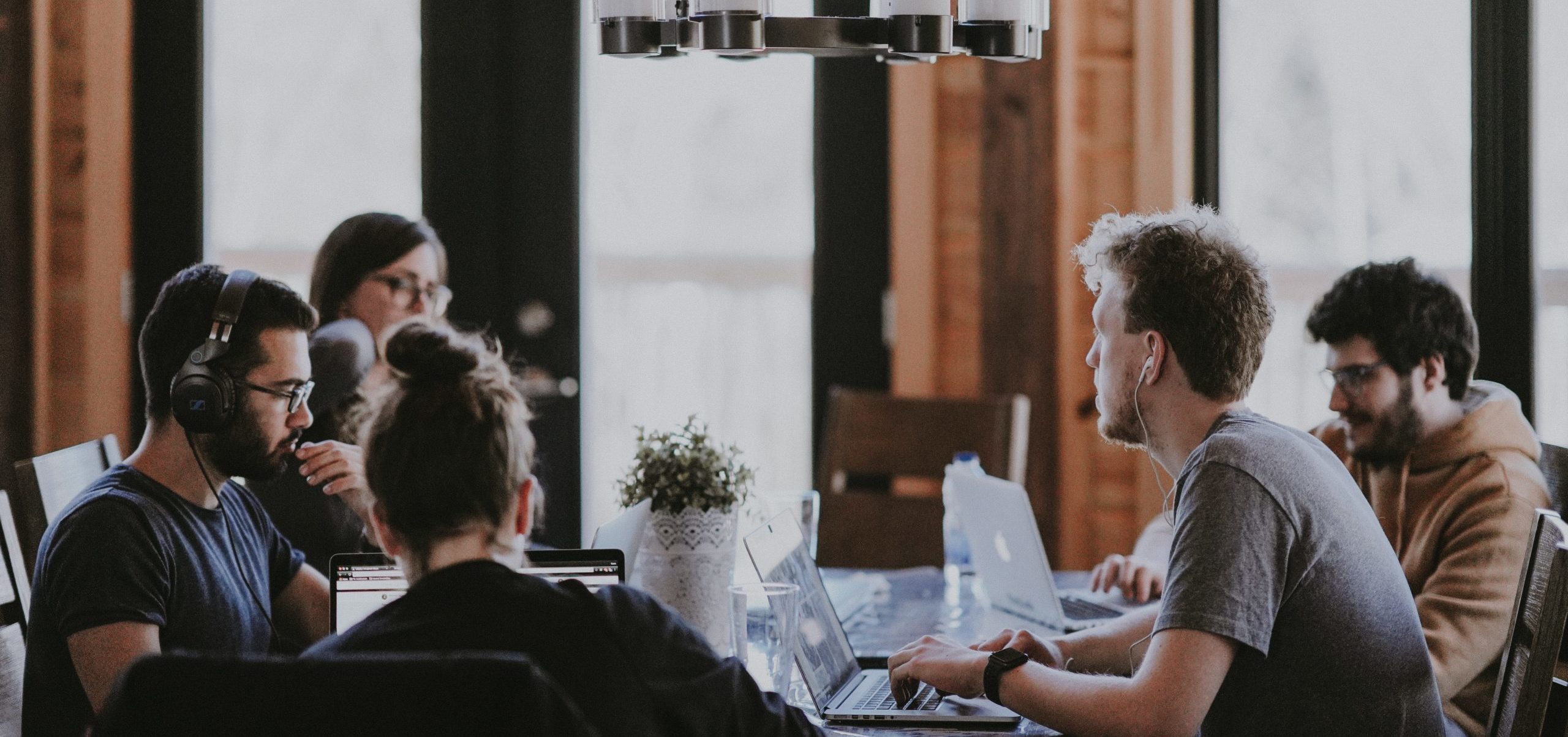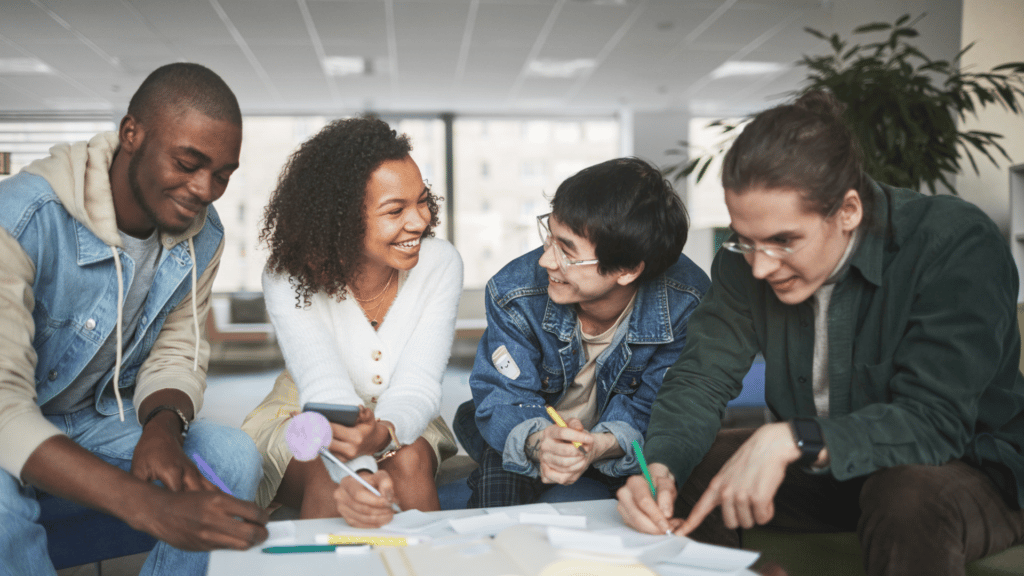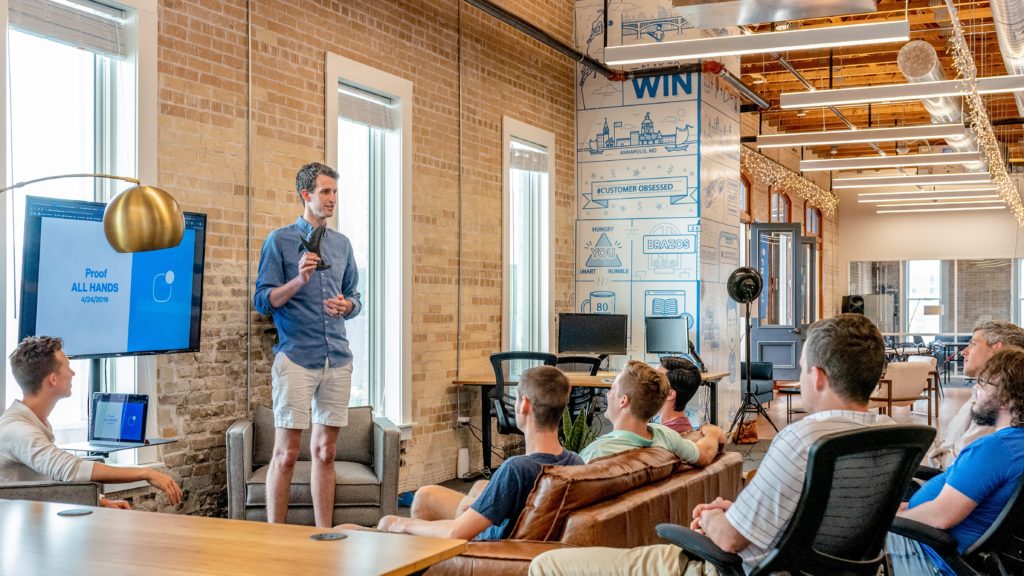Socialisation is a critical aspect of human learning, from our earliest moments through to school, university, working life, and beyond. Every day, everywhere, we learn from observing how other people behave, even if we don’t notice it.
A popular pedagogical principle known as social learning theory stems from this idea. In this article, we’ll dive deep into the theory, explaining its origins, key concepts, and applications in higher education settings.
By the end of this article, you’ll know how to use social learning theory to achieve exceptional outcomes for your students. Let’s begin!
What is social learning theory?
Social learning theory (SLT), also known as social cognitive theory, stems from the idea that people can learn new behaviours and skills by imitating or observing others. Canadian-American psychologist Albert Bandura OC first proposed the theory in the late 1970s while researching the cause of aggressive behaviour in young children.
Social learning theory suggests a connection between human behaviour and perceived self-efficacy (i.e. a person’s belief in their ability to achieve goals). According to Bandura, self-efficacy flows from four sources:
- Performance accomplishments
- Vicarious experience
- Verbal persuasion
- Psychological states
Performance accomplishments involve processes that help learners achieve certain tasks, leading to more complicated or complex objectives.
Vicarious experience is all about observing other people, including their behaviours and perceivable emotions. Bandura’s research suggests this behaviour helps learners gain experience and knowledge without actual participation.
Verbal persuasion involves offering encouragement to help a person achieve a task or reach a goal, such as compliments, advice, and support.
Finally, psychological states include physical and emotional states. In Bandura’s view, a learner must be relaxed and rested before attempting a new behaviour to achieve optimal results. Restless students are unlikely to achieve such behaviour.
What is the main idea of social learning?
Bandura’s social learning theory follows an idea you’ve likely heard before—humans are social creatures, benefiting enormously from interaction with and observation of other people. This concept is especially clear in early life, where nearly all our behaviours stem from observing parents and caregivers.
But, according to SLT, observational and vicarious learning continues into later childhood, adolescence, and even adulthood.
For example, a 2001 study published in Nurse Education Today discusses how SLT relates to practice-oriented professions such as nursing, where highly-trained nurses model appropriate behaviours to teach students clinical skills, professional attitudes, and how to interact with patients and other staff.
The study goes on to note how social learning theory intervention is significant in maintaining discipline and social conformity while increasing assertiveness and confidence among graduate nurses.
The components of social and observational learning
According to Bandura, observational learning cannot occur without the appropriate underlying cognitive factors. Individuals (and therefore students) won’t simply observe behaviours and automatically imitate them—some thought must occur before this happens. Bandura calls these thoughts mediational processes.
SLT divides these meditational processes into four core components, each playing a role in how people learn socially. In this section, we’ll go into more detail about each of these components and how they might apply in higher education settings.
Attention
Without due attention, optimal learning can’t take place. Learners must be focused on a task to achieve the full benefits.
One great way to keep your learners focused is to present topics in unique, unusual, and ‘out-of-the-box’ ways, such as through exciting stories with real-world relevance or physical demonstrations.
Microlearning, which involves presenting information in short bursts, is another great way to hold attention and keep your learners focused on the task at hand.
Retention
For a student to accurately reproduce learned behaviours, they must remember or retain its features. Retention rates can waver depending on the observer’s cognitive capabilities, rehearsal levels, and the complexity of the event.
According to Bandura, retention requires both visual and verbal cognitive processes. Verbal instruction is preferable in the most complex scenarios.
Reproduction
This component involves a student’s ability to reproduce the observed behaviour. It’s important to note that accurate reproduction is not always possible—individuals are limited by their physical and cognitive abilities.
Accurate reproduction also requires thorough observation. Bandura suggests that reinforcing behaviours such as self-observation and effective feedback from others can help.
Motivation
Motivation describes an individual’s desire to reproduce (or not reproduce) observed behaviours. Whether or not a person chooses to reproduce an action can depend on their motives, anticipated consequences, internal standards, the action’s functional value, and the environment.
Why is social learning important?
Social learning is important and relevant across multiple disciplines, from criminology to developmental psychology and even artificial intelligence. It is vital in understanding most human behaviour—especially how it is acquired and maintained.
In educational contexts, social learning strategies offer many benefits, including:
- Improved knowledge acquisition
- Stronger retention
- Modelling particular behaviour
- Enhanced learning outcomes
These benefits largely stem from the inherent motivation and encouragement involved in social learning.
A 2015 article published in Current Opinion in Environmental Sustainability posits that social learning is critical for transformation and progress, promoting a stronger sense of agency among individuals and groups. In other words, it motivates students to change the world in ways that benefit society as a whole.
The pros and cons of the social learning process
SLT has both proponents and opponents, each with compelling arguments for and against social learning concepts and their corresponding models. Below, we’ll discuss some key advantages and disadvantages to help you decide whether SLT is right for your classroom.
Advantages
SLT offers many benefits to students, educators, and educational institutions alike. First of all, it’s a natural, innate way to learn that blends well with other modern pedagogies like experiential, project-based, and gamified learning.
We all learn socially each day, whether we’re conscious of it or not. We might unknowingly pick up a slang term a friend uses and add it to our vocabulary, or learn a new cooking skill while watching daytime television.
Social learning also opens up communal skill-sharing opportunities, where students can learn from peers, educators, and positive role models. It’s also a great way to build retention thanks to its engaging, motivating, and collaborative nature.
For graduates moving into the workforce, social learning is also highly beneficial. Students who know how to optimise learning through observation and imitation are likely to progress more smoothly in their future careers.
Disadvantages
While social learning theory has many strengths, it also has some drawbacks. One key weakness is the lack of accountability within SLT models—that is, the theory places so much emphasis on environmental factors, it fails to acknowledge the importance of individual accountability.
It may be better to take a balanced approach here, considering how the social environment can influence human learning as well as how students process and handle new information.
Another disadvantage involves the methods Bandura used while developing his theory. Many of his ideas stemmed from research into children’s behaviour in lab settings, which does not necessarily reflect behaviours in daily life.
How to incorporate social learning techniques in your classroom
According to Bandura, the three principles of social learning are:
- The live model, which involves acting out or physically demonstrating behaviours.
- The symbolic model, where fictional or real characters in movies, TV programs, books, or online media display behaviours.
- The verbal instructional model, where educators describe or explain behaviours through spoken language.
You can incorporate one or several of these models in your classroom to reap the benefits of social learning theory. The best model you use will depend on the type of content you’re teaching and your student’s unique learning styles.
Through the power of technology, you can deliver social learning even in online or hybrid learning environments. Digital communication tools, such as live chats, webinars, and video conferences are all effective options.
Examples of social learning
There are many ways to incorporate social learning techniques in the classroom. Here are just a few examples.
You could use the live model to show health science students how to assist a patient with injury recovery exercises in an engaging, immersive way. Through active learning observation, students will learn practical skills and the appropriate behaviours for assisting and interacting with patients.
As another example, you could use the symbolic model by showing a class of aviation students an instructional video demonstrating the features and functions of an aeroplane. Here, students learn how aeroplanes work and how to safely interact with their components from the safety of the classroom.
Finally, using the verbal instructional model, you could deliver a lecture to journalism students on how to draft and present a compelling story.
Challenges and criticisms of social learning
Social learning offers some challenges. Importantly, when Bandura first proposed his social learning theory, there was little research into children and adults with social learning differences, such as those with autism and ADHD.
It is critical to recognise that students with social learning differences, or reduced interest in socialisation, may not benefit as strongly from social learning techniques. It’s better to consider every student’s learning style, catering to their unique needs.
When used excessively, social learning techniques may limit innovation. Progress typically comes from fresh, unconventional ideas, which is why educators shouldn’t rely entirely on the SLT model. Introspection is just as important as learning from others.
How Practera can help
Practera offers several managed services and authentic industry programs to help educators and higher education institutions deliver powerful social learning experiences.
All you need to do is define your project goals—such as your industry, learner numbers, delivery dates, and desired theme—and we’ll connect your students with transformative and authentic programs to help them build vital professional skills and connections. With real-world projects, we have empowered almost 1 million learners globally with industry-recognised career skills.
Using our platform, projects will include access to full-scale analytics and feedback while emphasising strong social connections between students, educators, clients, universities, and industry leaders.
To learn more about Practera and what we can do for your higher education institution, connect with us for a discussion today. You can also download our white paper for a detailed breakdown of online project learning and its benefits. You can also trial our industry experience program for free for a short time here.




